Late1800afrench Soundeffect 20th Century Art Music Music Train Whistle
History of Sound in Theatre
Early Sound
Around 3000BC, China and India accompanied their theatrical productions with incorporated music and sound, and nosotros know of examples of audio usage throughout the history of theatre. In Greek tragedies and comedies the productions call for storms, earthquakes, and thunder when gods announced. There is all-encompassing history of the mechanism that was used scenically; and even though there are simply a few mentions of it, in that location were also uses of machinery in place for the few sound effects they needed. In the Roman theatre, Heron of Alexandria invented a thunder machine using contumely balls that would drib onto dried hides arranged like a kettledrum, and a wind motorcar with fabric draped over a rotating bicycle.
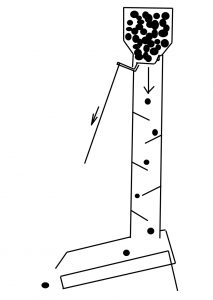
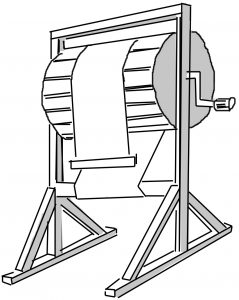
Roman Empire
During the Roman Empire, Aristotle noted that the chorus could be heard better on a hard surface rather than when they stood on sand or straw, beginning the agreement of reflection and assimilation for audience knowledge. You lot could say he was the showtime theatre acoustician. Because the Greeks as well had an agreement of how sound traveled to an audience with their stepped seating structure, in the 1st century BC, Vitruvius, a Roman architect, used the Greek structure to build new theatres, simply he had a deeper understanding of audio as he was known to exist the first to merits that audio travels in waves like a ripples afterward a stone is thrown in water. His work was instrumental in creating the basis of mod architectural acoustic design.
Medieval and Jacobean
Sound furnishings were needed for the depiction of hell and the appearance of God in religious plays, the tools of drums and stones in reverberant machinery held over from the Greek theatre. And of grade, both sung and instrumental music played a large part of medieval plays for both transitions and ambient. In Elizabethan theatre, audiences expected more realism in their entertainment and sound effects, and music begins to be written into texts. As theatre was moving indoors and becoming more professional, sound and music were used to create atmosphere, reproducing pistols, clocks, horses, fanfares, or alarms; but also sound was now beingness used for symbolic effect of the supernatural and to help create drama. A description of audio effects is listed in A Dictionary of Stage Directions in English Drama 1580-1642, which includes everything from simple effects to specific needs for battle scenes.
For a short fourth dimension after Shakespeare'southward death until 1660, theatre declined in England, and after the English Civil War began in 1642, theatre was forbidden. When King Charles was restored to the throne after the war, theatres began to come alive again in part because the King, while exiled in French republic, was accustomed to seeing proscenium-designed theatre. Shortly after this, the showtime theatres were built in America only they did not survive for more than a few years at a time. It was not until the early on 1800's that theatres in New York, Philadelphia, St. Louis, Chicago, and San Francisco continuously operated.
17th – 18th – 19th Century of Sound
The appearance of mechanical devices beingness developed inside the realm of sound effects and sound blueprint in the edifice of thunder runs (cannonball rolled through chutes), thunder sheets, air current and rain makers. The Bristol Erstwhile Vic recently re-activated their 'thunder run' for their 250th anniversary (to come across a video). These devices are too highly adult to be cued past an equivalent to an SM in the time, and take a large dedicated "sound crew" to a type of Sound Designer or Manager guided to exist executed.
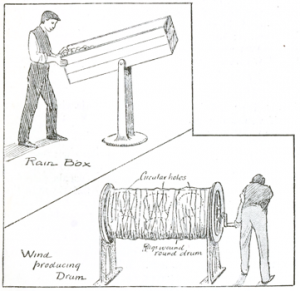
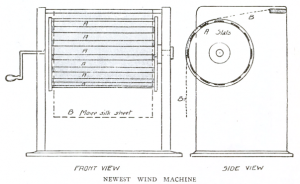
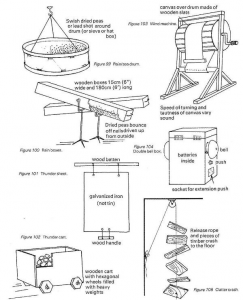
Victorian Age and the Use of Recorded Sound
In Michael Booth's book Theatre in the Victorian Age, there is documentation of the first use of recorded sound in theatre; a phonograph playing a infant'due south weep was heard in a London theatre in 1890. In Theatre Mag in 1906, at that place are 2 photographs showing the recording of sound effects into the horn of a gramophone for use in Stephen Phillips' tragedy Nero.
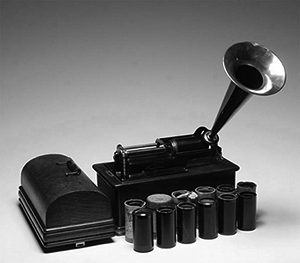 The first applied sound recording and reproduction device was the mechanical phonograph cylinder, invented past Thomas Edison in 1877
The first applied sound recording and reproduction device was the mechanical phonograph cylinder, invented past Thomas Edison in 1877
Bertolt Brecht cites a play about Rasputin written in 1927 past Alexej Tolstoi that includes a recording of Lenin'south voice. And sound design began to evolve even further, as long-playing records were able to hold more content.
Anarchistic Audio
In 1913, Italian Futurist composer Luigi Russolo built a sound-making device called the intonarumori. This mechanical tool simulated both natural and manmade audio effects for Futurist theatrical and musical performances. He wrote a treatise titled The Art of Noises, which was written as a manifesto in which he attacks former presentations of classical instruments and advocates the fierce down of the classical construction and presentational methods of the music formats of his time. This could exist intimated every bit the side by side stage of the utilize of unconventional instruments to simulate sound furnishings and classical instrumentation.
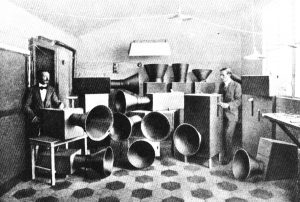
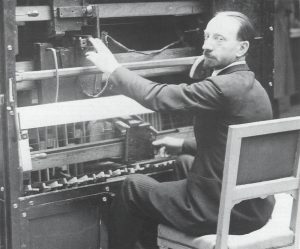
Foley in Theatre
Eventually, the scratchiness of recordings was replaced with a crew of effects people for meliorate sound quality. Circa 1930, the American company, Cleon Throckmorton Inc., stated in an advertizement that they would build-to-lodge mechanism to produce audio effects saying, "every theatre should take its thunder and air current apparatus." At that fourth dimension a thunder sheet cost around $7 and a 14" pulsate wind machine price around $15. This is during the Great Depression when ticket sales ranged from $.25-$1.
And in the NY Herald on Baronial 27, 1944, a cartoon depicting Foley artists backstage at the Broadhurst theatre performing the sound effects for Ten Little Indians shows 4 men operating the mechanism used to create surf, a boat motor, wind, and something heavy dropping.
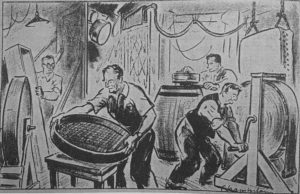
Hollywood Comes to Broadway
The field begins to grow when Hollywood directors such as Garson Kanin and Arthur Penn, start directing Broadway productions in the 1950'due south. Because they had transitioned from silent films to 'talkies,' they had become accustomed to a department of people in the position of authorization regarding audio and music. Theatre had not yet developed this field; there were no designers of recorded sound. It would unremarkably fall upon the phase manager to find the sound furnishings that the director wanted, and an electrician would play the recordings for performances. In fourth dimension, considering savvier audiences could distinguish between recorded and live sounds, creating alive backstage effects remained common practice for decades.
Kickoff Recognitions
The first people to receive the credit for Sound Design were Prue Williams and David Collison, for the theatrical season in 1959 at London's Lyric Theatre Hammersmith. The first men to receive the championship of Sound Designer on Broadway was Jack Mann in 1961 for his work on Show Girl and Abe Jacob who negotiated his title for Jesus Christ Superstar in 1971. And the kickoff person noted as Audio Designer in regional US theatre is Dan Dugan in 1968 at the American Solarium Theatre in San Francisco. As the technology of recording and playback of music and audio advances, and then does the career of the sound designer.

The Advance of Technology
You lot cannot move forward in telling the history of the field of sound design without pointing out the technological advances. Technologically, someone needed to be in charge of the growing use of equipment and knowledge it took to brand sound pattern work. Merely I would be remiss if I did not state that artistically engineering science makes choices easier to achieve, because a designer still has to take into account story, character, emotions, environments, manner, genre, and apply tools of music, psychology, and acoustics in order to impress upon an audience and bring them on an emotional sonic journey.
Let's take a look at how engineering advances changed how sound was recorded and played back.
- Past the end of the 1950'south, long-playing records were replaced with reel-to-reel tape, and with that came the possibility of alteration content more easily than pressing another disc.
- Dolby Racket Reduction (DNR) was introduced in 1966 and became an industry standard to a cleaner sounding quality of recorded music.
- By the end of the 1970's cassette tapes outnumbered all disc and tape usage. It was easy to amend content just hard to use as playback as yous would line up cassettes to be played one past one.
- By the terminate of the 1980'due south the compact disc and Digital Sound Tape (DAT) became the popular fashion of playback, with the new auto-cue feature with DAT that fabricated it possible to play a cue and take the tape stop before the next cue.
- In 1992 Sony came out with the MiniDisc player (Dr.) and theatres immediately picked it up for playback. You could better content chop-chop on your calculator, burn it to a CD, transfer information technology to the MD, rename and reorder the cues on the disc, and it as well would pause at the end of a cue.
Sound designers could now work during technical rehearsals. This is one of the major shifting points in the artistry of the profession because sound designers were legitimized as collaborators at present that they were able to work in the theatre with anybody else. This is not to say that sound designers were not artistic and valuable to the process as they recorded and amended their work alone; this points out that others could now see a sound designer at work in the room, and with this knowledge came understanding.
First Contracts in the The states
Betwixt 1980 and 1988, United States Institute for Theatre Technology'due south (USITT) first Sound Design Commission sought to define the duties, standards, responsibilities, and procedures of a theatre audio designer in North America. A certificate was drawn upwards and provided to both the Associated Designers of Canada (ADC) and David Goodman at the Florida United Scenic Artists (USA829) local, as both organizations were well-nigh to represent sound designers in the 1990'south and needed to sympathize contract language of expectations. USA829 did non prefer the contract until 2006 when unionization happened and accepted sound designers. Before this sound designers worked with Letters of Agreement.
MIDI and Show Command
In the 1980'south and 1990's, Musical Instrument Digital Interface (MIDI) and digital technology helped sound design grow very quickly. And eventually computerized audio systems in a theatre were essential for live show command. The largest correspondent to MIDI Show Control (MSC) specifications came from Walt Disney who utilized systems to control their Disney-MGM Studios theme park in 1989. In 1990 Charlie Richmond headed the USITT MIDI Forum, a group that included worldwide developers and designers from theatre sound and lighting. They created a bear witness control standard, and in 1991 the MIDI Manufacturers Association (MMA) and Japan MIDI Standards Committee (JMSC) ratified the specifications they laid out. Utilization of the MSC specifications was first used in Disney's Magic Kingdom Parade at Walt Disney World in 1991.
Moving this technology into theatres took years to prefer because of the lack of capability, finance, and the challenges with the calibration of computerizing a organization. With MIDI control, yous could now use a sampler for playback. Your files would exist uploaded into a storage unit and through a MIDI command you could trigger a specific file from a musical keyboard. These machines became smaller every bit digital storage space shrunk, but eventually, Level Command Systems (LCS), Cricket, SFX, and QLab quickly were becoming the standards in theatre show command, the newest making an easier interface than the concluding. They eventually fabricated all older formats: tape players, reel-to-reel tape, cassette tape, compact disc, mini disc, and samplers obsolete for usage in theatre.
Now, in the 21st century, sound designers can be faster in tech than other elements for the first time. Content can exist amended in any dreamed-upward manner and inside minutes information technology tin can be ready to work with the actors on phase. This is a very fast advance in the field and no other stagecraft element has grown so apace in so short a time, becoming a valued artistic component of professional theatre.
Union Representation, Tony Awards, and TSDCA
In 2008 after years of campaigning by USA829, who now solidly represent sound designers in their union, the Tony Award Assistants Commission added ii awards for sound with Mic Pool winning the first Best Audio in a Play award for The 39 Steps and Scott Lehrer winning the first All-time Sound in a Musical award for Southward Pacific. Yet, in 2014, simply half dozen years later, the Tony Award Administration Committee announced that both awards would be eliminated.
Questions about the legitimate artistry, and how to properly gauge audio design, were a catalyst for the formation of The Theatrical Sound Designers and Composers Association (TSDCA). TSDCA was formed in 2015 to help brainwash the theater-going public, also as to back up and advocate for the members of the field.
I could argue that with the advances in technology, the artistry of sound design is taken for granted because it is not as magical as it in one case seemed when theatre artists created the impossible in the room. Or peradventure information technology's that equally a species we have all become accepted to applied science and it no longer holds any mystery. Either way, the artistry of sound design is still is an integral role to how man beings communicate their stories.
Back to Pinnacle
How Sound Works
Sound Waves
Sound waves emanate from an object, which is in contact with a medium of transmission, and eventually is perceived equally audio. Nosotros usually remember of sound traveling through air as the most common medium, merely sound waves can likewise pass through solids and liquids at varying speeds. The homo ear has a very intricate arrangement of intercepting these sound waves and brings meaning to them through the auditory nerves in the encephalon. This produces the second meaning when we speak of sound, a more concrete and emotional sensation of hearing, which is how the sound feels, such as "the crickets at night are very peaceful." This folio will focus on the outset significant, the bodily transmission of the sound wave and how the infinitesimal variations fluctuate in a higher place and below atmospheric pressure causing waves of compression and rarefaction.
Changed Square Law
The inverse foursquare law which states that the further a audio wave travels away from the betoken of actuation, the less the intensity of pressure change occurs. To human being ears, this to us sounds equally if the sound is getting quieter when in reality the atmospheric changes are getting smaller with distance and fourth dimension. Over time, the free energy dissipates. At the signal of emanation, the free energy of the sound occupies more physical infinite. As it travels, and we encounter the sound at a unmarried point of reception in a broader area, it appears to exist quieter. Outdoors, with no reflecting or absorbing objects, sound will behave in accordance with the inverse square police; this condition is known as a costless field. There is nothing interrupting the flow of energy from the betoken of emanation to the point of reception.
Wave Cycle
A sound wave cycle is adamant past measuring the initial increase in atmospheric pressure from the steady state, followed by the respective drop below the steady country, and and so the render support to the steady state. The sound wave is in reality squeezing together atmospheric particles more than normal and so is pulling them autonomously further than normal. When y'all factor the rate of this into the equation, the faster the object vibrates the more wave cycles are produced per 2d. The corporeality of wave cycles that occur in one second is expressed as the frequency of the wave. The greater the number of vibrations, we define as a higher frequency of a wave wheel, which gives the perception of being higher in pitch. The fewer the number of vibrations, nosotros ascertain as a lower frequency of wave bike, giving the perception of being lower in pitch.
Frequency
Frequency is relative to pitch in our perception, only pitch is a subjective sensation. You may not exist able to hear a change in pitch with a very modest modify in the frequency of a sound wave. These frequencies were named afterwards Heinrich Hertz, and the term Hertz (Hz) measures the wave cycles per second. If the frequency is over grand Hz, we specify this with the suffix kiloHertz (kHz). For example, a sound wave measuring a frequency of fifteen,500 cycles per second would be notated as 15.five kHz. Perception of these waves varies from person to person, taking into account age and gender. The perception of the everyman audible frequency is effectually 15 Hz. In the perception of the higher frequencies is where you encounter the greater variance. Young women tend to take a college range of hearing, up to 20 kHz, when the average loftier range is around 15-eighteen kHz. With age, and exposure to high decibel levels of sound pressure, the ability to hear high frequencies declines. Audio pressure levels are measured with the decibel scale sound pressure level (dBspl).
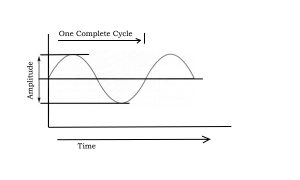
In this diagram of the sinusoidal (sine) wave higher up, the steady state is the line in the centre. The initial pinch of atmospheric pressure takes the wave higher up that steady state. The respective turn down beneath the steady country is the rarefaction of the atmospheric pressure. One full period is noted when the pressure comes back up again to the steady state. Bold an impulse sound, Amplitude, or the height of the waveform, will change through the amount of change in pressure over fourth dimension. At the start of a wave, you'll find a greater distance from the steady state, and with time, in a free field, the size of the pressure diminishes until negligible and the amplitude (height) is smaller. To the human being ear, Amplitude equates to loudness.
Sound Bounce and Absorption
Sound travels through, around, and bounces off anything that is in the path of the wave; every object with mass, with which a sound wave comes into contact, will vibrate as well. This vibration of another object through sound is considered the resonant frequency of that detail object. When sound bounces off of an object it is considered the reflection, which is similar to the way calorie-free bounces off of a mirror. Lite particles are very small in comparison to sound waves, so especially low frequency waves (larger in size) will just reflect off of certain sized objects. The size of the object will determine the frequencies that will flow effectually and reverberate off of it. If an object is between yous and the source of the sound wave, the object creates a shadow of itself between you and the source, and macerated perception of frequencies occurs considering of the absorption and reflection that object causes. Harder reflective objects act as rebound for the wave, and softer absorbing objects soak in some of the free energy of the wave.
Reverberation
When sound bounces off of ceilings, floors, and walls, the reflections combine with the original moving ridge and have different effects on a listener depending on where they interact with the audio. The closer you are to the source of the original moving ridge, the less you will hear the reflected waves. The farther away y'all are from the original source, the more the combined effect is apparent and can at times obscure the original sound wave. What is chosen the critical distance is the betoken where the energy from the original source equals the energy from the reflections. This can vary according to the acoustic conditions of the space in which the sound is traveling. When you reach the betoken in the space outside of the critical distance where the reflected sounds diffuse the energy of the original source, this is called the reverberant field, and yous will lose clarity in the effect with a longer reverberant fourth dimension. This is not to be confused with an echo, which is when sound waves bounciness from a highly reflective surface and repeat.
Sound Designers empathise the mode sound is generated, moves, reacts, and dissipates in any surround. It is the foundation to the understanding of what happens when human being beings come up into contact with audio.
Back to Summit
How We Hear
Excerpt from The Fine art of Theatrical Sound Design – A Practical Guide by Victoria Deiorio
Biology, Physics, and Psychology
When nosotros recreate life or dream upward a new version of our being, as we do in theatre, we rely on the emotional response of an audience to farther our intention of why we wanted to create it in the first place. Therefore, we must understand how what we practice affects a homo body sensorily. And in social club to understand human reaction to sound we accept to go back to the kickoff of life on the planet and how hearing came to be.
The start eukaryotic life forms (a term that is characterized by organisms with well-defined cells) sensed vibration. Vibration sensitivity is one of the very first sensory systems that began with the externalization of proteins that created small mobile hairs that we now call cilia. This helped the primeval life forms to motion around, and transformed them from passive to active organisms. The hairs moved in a way that created a sensory organization that could detect the changes in the motility of the fluid in which they lived.
At starting time this was helpful considering it ascertained the indication of predators or prey. Eventually an organism could detect its environment at a distance because of the vibration information technology felt through the surrounding fluid; substantially they were interpreting the vibration through the sense of affect the cilia. To go from this elementary arrangement to the complexity of the human ear is quite an evolutionary jump that took billions of years to create, only we cannot deny the link.
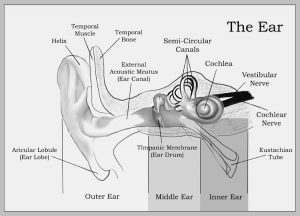
Now if we look at the human ear, it is an organ that is equipped to perceive differences in atmospheric pressure caused by alternations in air pressure. The inner ear contains the cochlea, a snail shaped spiral construction that is filled with fluid to aid in balance and hearing. In the fluid-filled spiral there are mechanosensing organelles of hair cells almost 10-50 micrometers in length. These hairs capture high and low frequencies depending on their placement within the cochlea (higher frequencies at the beginning, and lower frequencies farther in of the spiral). They convert mechanical and pressure level stimuli into electric stimuli that then travel along via the cochlear aqueduct, which contains cerebrospinal fluid, to the subarachnoid space in the central nervous system.
Simply put, sound enters the ear; vibrations are detected in the fluid by cilia and are converted into perception at the encephalon. You may also desire to take note that we utilise this aforementioned procedure of capturing vibrations and creating an electrical point, to and so exist interpreted through different 'brains' of engineering science as our signal flow of the mechanical side of our work every bit sound designers. Our ears are the best example of organic signal flow.
Audio can be split between two aspects, physics and psychology. In physics we don't remap every vibration on a ane-to-1 ground. That would be too overwhelming for us to translate.
In that location are two innate weather to our hearing.
- Firstly, we have a specific range of frequencies within which nosotros hear. We don't hear the highest frequencies that a bat produces when flying around on a quiet rural evening. And a railroad train rumble to u.s.a. is not nearly as violent equally it is for an elephant in a urban center zoo that uses infrasonic (extreme low cease frequency) advice.
- Secondly, from our perceptible frequencies nosotros selectively choose what we want to hear so that the aural earth around us is not overpowering. When new meaning is not being introduced, we selectively choose to filter out what we don't need to hear.
This brings us to the attribute of psychology though perception and psychophysics, the study of the human relationship between stimuli, the sensations, and the perceptions evoked past those stimuli.
Perception
The start step to the development and evolution of the mind is the activation of psychophysics in the brain. If yous have the agreement of what you are experiencing around you, you can apply that understanding to learn and grow. This is how the heed evolves. And in our evolution our minds developed a complex way to interpret vibrations and frequency into meaning and emotion.
Everything in our world vibrates considering where there is energy at that place is a vibratory region, some more complex than others simply never totally silent. The encephalon seeks patterns and is continually identifying the correlation of sensation with perception of the energy that hits our bodies at a constant rate. When the brain interprets repetitive vibration, information technology creates the neural pathway of understanding around that vibration, which is why nosotros tin selectively block out audio we don't need to hear, i.e. the hum of fluorescent lights or the whir of a computer. Merely when a random pattern occurs like a loud dissonance behind us, we immediately conform our focus to cover what made that sound, where information technology is in juxtaposition to us, and question if we are in danger.
Hearing is a fast processing system. Not merely can the hair cells in your ears pinpoint vibrations, and specific points of phase of a vibration (upward to 5,000 times per second), information technology tin can also hear changes to that vibration 200 times per 2d at a perceptual level. It takes a thousandth of a 2d to perceive the vibration in the inner ear, a few milliseconds later on the encephalon has adamant where the sound is coming from, and information technology hits the auditory cortex where we perceive pregnant of the sound in less than 50 milliseconds from when the vibration hit the outer ear.
The link between visual and sound is an important cistron to our work as sound designers. At the auditory cortex we identify tone and comprehension of speech, but information technology is not simply for sound. There are links betwixt sound and vision in sections of the brain to help with comprehension. For instance, the auditory cortex can also assistance with recognizing familiar faces that accompany familiar voices.
The more we learn well-nigh the scientific discipline of the brain, the more physical interconnectedness nosotros notice between the sensory perception functions. This is why when sound in theatre matches the visual aspects of what is seen, it tin can exist an incredibly satisfying experience. It is the recreation of life itself and when it is precisely repeated, it is as though we are actually living what is being presented in the production.
What is fascinating about the perception of hearing is that it does not solely occur in the auditory parts of the encephalon, information technology projects to the limbic organisation also. The limbic organisation controls the physical functions of heart rate and blood pressure, only besides cognitive part such as retention formation, attention span, and emotional response. Information technology is why music can not just modify your heart rate, just also bring you dorsum in fourth dimension to a specific moment that contained detailed emotions. This link to the limbic organisation is the aspect of cerebral hearing we use the well-nigh when placing music into a theatrical performance to support what is happening emotionally on stage.
Philosophy of How We Hear
Equally a audio designer, you need to know what the collective conscious experience is with audio. Whatever experience that homo beings encounter can be reproduced on stage either in direct mirroring or a metaphoric symbol. Although this happens at the physical level of re-creation, often considering it is a dramatized telling of a story, the reproduction lives within the metaphysical level of experience.
In society to sympathize the difference betwixt the physical and metaphysical feel of sound, we must utilise Phenomenology (a philosophy which deals with consciousness, thought, and experience). When we are able to break apart the feel of hearing audio to chief control over information technology, we can use information technology as a tool to affect others. You want to acquire sound's constitution in order to be able to control it.
About theatregoers do not recognize the audio that accompanies a functioning unless they are specifically guided to observe it. We provide the perception of depth of the moment-to-moment reality by filling in the gaps of where the visual leaves off. In order to recreate true to life experiences, we supply the aural world in which the issue exists.
If we do non unremarkably accept note of how nosotros procedure sound in our lives and its existence in our experiences, nosotros will not exist able to ascertain its presence in a theatrical product as an audition member. And for most people, audio in theatre volition exist imperceptible because their ears are not tuned to know how they perceive sound. We, as sound designers, desire to use that to our advantage. But nosotros can just do that if we completely understand how homo beings procedure audio.
Manipulative Usage Because of Evolution
In a theatrical environment the audience is listening with goal-directed attention, which focuses the sensory and cognitive skill on a limited set of inputs. Therefore, nosotros as sound designers take the ability to shape the sonic journeying and create specific selected frequencies and attenuation past making the environment equally complex or pure as we determine in our design.
We use stimulus-based attending when we desire to capture awareness and redirect focus because certain audio elements create triggers due to the lack of previous neural path routing. We create sonic environments past bringing attention to only what we supply; at that place is zip for an audition to filter out, it is all on purpose.
When a sudden loud audio happens it makes the audience jump, and at present if we add to information technology a low frequency tone, the brain automatically starts creating subconscious comparisons because the input limitation is the only information the audition is receiving. We control what they hear and how they hear information technology.
Depression frequencies have their ain special response in a man. In that location is an evolutionary reason equally to why depression frequencies immediately make the brain suspect there is danger nearby. Some have equated that hearing high amplitude infrasonic aspects of an animal growl immediately forces humans into a fight or flight response. More importantly though, loud infrasonic sound is not merely heard, it is felt. It vibrates the entire torso including the internal organs. Even with the subtlest use of low frequency, yous can create unease internally.
One of the most powerful tools for a audio designer is the power to create the feeling of apparent silence. This is relative to the sound feel preceding and following the silence. Information technology has its own emotional response considering we are commonly subconsciously subjected to constant background noise. The absenteeism of sound increases attending and it can increase the ear'due south sensitivity.
The increment of attention because of silence has the same result as the increment of attention from a sudden loud dissonance with one exception; the detection of the absence of sound is slower. Perhaps this comes from the 'silence before the tempest' feeling of impending danger noting that something is wrong because something is missing. Or information technology may come from how in nature insects finish making dissonance when a predator is well-nigh.
Information technology would be safe to presume that fearfulness governs survival, making yous either stay and fight, or run away. And this learned evolutionary behavior comes from the demand to survive and has dictated the commonality of our reaction to this type of sound.
There is no specific region of the brain that governs positive complex emotions derived from sound, making it more than complicated to empathise what triggers information technology. Positive emotions come from behavioral development. What makes one person excited could be slow to the next considering it is less of a reactive emotion than one that is congenital from experience.
At that place are universal sonic elements that imply that loudness equals intensity, low frequency equals power and large size, slowness equals inertia, and quickness equals imminence. These elements common to sonic communication are exactly what sound designers utilise to guide an audience's response to a specific storytelling journey.
Circuitous emotional response comes from complex stimuli, and in theatre the cleanest mode to produce positive complex responses is to accept multisensory integration. In simple terms, if the sound matches the visual in timing, amplitude, and tone, it produces a gratifying reaction fifty-fifty if the emotion is negative. This is because it activates more than regions of the encephalon.
Just permit'south be clear about our specific medium, the most powerful and common stimulus for emotional response is sound. And this resides mostly in our hearing and association of music.
Music
Music draws attention to itself, particularly in music that is non sung. The meaning lies in the sound of the music. Nosotros heed reflectively to wordless music. It enlivens the torso because information technology plays upon a full range of self-presence. Music is felt in its rhythms and movements. The filling of auditory infinite equates to losing distance as you mind, and therefore creates the impression of penetration.
The sound of music is not the sound of unattended things that we experience in our day-to-day existence. It is constructed and therefore curiously unlike. Each slice of music, each genre or style is a new language to experience. Music comes to be from silence and it shows the infinite of silence as possibility. The tone waxes and wanes at the discretion of the musician, and composers can explore the differences between being and becoming, and actuality and potentiality.
In his book Listening and Voice: Phenomenologies of Audio, Don Ihde remarks; "The purity of music in its ecstatic surrounding presence overwhelms my ordinary connectedness with things and then that I practice not even primarily hear the symphony as the sounds of instruments. In the penetrating totality of the musical synthesis it is easy to forget the sound as the sound of the orchestra and the music floats through experience. Part of its enchantment is in obliteration of things."
Music can be simply broken down into the idea that information technology is a score with instrumentation. It is a type of performance. And if we look towards how nosotros reply to music, it tin can be found in the definition of each unique performance and its issue upon us. A score will tell a musician how to perform a piece of music, and they tin play it annotation-perfect. But one performance can vary from another because of the detail approach to the music by the individuals involved in creating it.
Because ane cannot properly consider a piece of work of art without because it every bit meaningful, and then the art of music must then be divers as having meaning. To define it every bit meaningful, would lead you to recollect that it is possible to actually say what a specific piece of music means. Everything is describable. But if yous put into words the meaning of music, it nearly seems to trivialize it because you lot can't seem to capture the entirety of its meaning.
What we can communicate when defining music is its characteristic. Nigh use emotion to do this. For example, the music can exist sad. But is it the particular phrase in the music that is sad; or is it the orchestration; or is information technology a totality of the entire piece that creates the illustration? Or more specifically, can it be the experience of hearing the music that creates the feeling of sadness? But even this is ambiguous because if you find a definition about how the music affected you emotionally, in describing information technology you even so have to find what about the expression was effective to anybody else who experienced it.
We can try to describe music in the sense of its animation. The properties of its move correspond to the movement properties of natural expression. A deplorable person moves slowly, and perhaps this is somehow mirrored in the piece of music. The dynamic graphic symbol of the music tin resemble human movement. Nonetheless this alone would also non fully explain what it is to feel sad music because human movement implies modify of location and musical movement does not.
When music is accompanying an additional form of expression as it does many times in theatre, you can evoke the same 2 reactions from an audition. The commencement is that the audience empathizes with the feel; they experience the sadness that the functioning is expressing (within). And the second is that they tin take a sympathetic reaction; they experience an emotion in response to what is being expressed (without).
What is so dynamic to music is that it can part as a metaphor to emotional life. Information technology can possess qualities of a psychological drama, it can raise a charge towards victory, it can struggle with impending danger, or it can even try to recover a past lost. And it tin can describe both emotional and psychological states of mind. Information technology is nigh as if the experience is beyond the music even though we are non separated from information technology. Our inner response may divert in our imagination, but information technology is the music that is guiding us. That is why the experience of listening to music is often described every bit transporting us.
Music is perhaps an ordered succession of thoughts that could be described as an harmonic and thematic plan by the composer. And in this idea we supply an application of dramatic technique to music in social club to create a chat betwixt the player and the listener. We use words like climax and denouement with a unity of tone and action. Nosotros fifty-fifty employ the term character. We develop concepts and use music as a discourse to express metaphor. Simply at times intellectual content is almost coincidental. We did not set up this conversation to be heard intellectually, information technology is intended to be felt emotionally. The composer and musician direct our aural perception equally the listener.
Feeling Music
It seems that music should lend itself to a scientific explanation of mathematics, frequency, limerick of tone, amplitude, and fourth dimension; all the same, in that location is so much more to music than what can be studied. There take been interpretations of different intervals in music and the reaction they elicit in the listener. The main determination of emotional response comes from whether the interval contains consonance or dissonance.
Consonance is a combination of notes that are harmonic considering of the relationship of their frequencies. Dissonance is the tension that is created from a lack of harmony in the human relationship of their frequencies. The specific determination of these terms has inverse throughout history with the exploration of new means of playing music and remains very hard to come to consensus over.
What is known scientifically is that the listener reacts with a different response to intervals that contain consonance rather than intervals that are dissonant. As this goes further into the meaning of perception when we take into business relationship the different emotional responses for intervals that are in a major key or in a minor central. This is why we tend to think of major keys as happy and minor keys as sorry. However, keep in mind that both major and minor keys can incorporate consonance and dissonance.
Instrumentation
Every musical instrument creates its own harmonics based on the fabric of which it is made and how it is played (struck, bowed, forced air, etc.). And these harmonics add to the perception of consonance and dissonance. This is the reason why a violin will produce a different emotional response than that of a tuba. Each instrument has its ain emotional tone; and when combined, the harmonics mix together in a style that creates a complexity of unlike emotional states.
When you identify that complication into a major or minor cardinal using either consonance or noise and vary the speed and volume, you attain music. A great composer uses each instrument'due south emotional tone, whether alone or in concert with other instruments, to convey what they want their audition to feel.
Rhythm
Rhythm can be defined as a temporal sequence imposed past metre and generated by musical motion. And nevertheless not all music is governed by metres and bar lines. Arabic music past instance composes its time into cycles that are asymmetrically added together. The partitioning of time by music is what we recognize as rhythm. For a audio designer information technology is important to note that the other attribute of rhythm is non about time; information technology is the virtual energy that flows through the music. This causes a human response that allows us to move with it in sympathy.
Each culture depends on its own interpretation of rhythm. A Merengue will accept a much different feeling than a Viennese waltz. The sociological and anthropological aspects to rhythm vary greatly, and rhythm is the lifeblood of how subgroups of people express themselves. Information technology tin be every bit wide as the rhythms of unlike countries, to the minuteness of different regions that live in close proximity. Rhythm is a form of expression and tin be extremely particular depending on who is creating it and who is listening to it.
Association of Music
Music is one of the strongest associational tools we tin utilise every bit sound designers.
One of the most often remarked upon association is the use of John Williams' theme music to the motion-picture show Jaws. A single tuba sounding very much alone slowly plays a heartbeat pattern that speeds up until it's accelerated to the betoken of danger.
This is the perfect example of how repetition and the change of footstep in music can crusade your eye rate to speed up or slow down. It is why nosotros experience calm with slower pieces of music, and excited with more complex or uneven tempos. The depression infrasonic resonance of the frequencies created by the tuba imparts the feeling of danger approaching. When matched with the visual aspect of what you are trying to convey, a woman swimming lone in the ocean at night, the association is a very powerful tool to generate mood, feeling, and emotion.
In audio design you likewise accept the ability to exercise listen control where you can send your audition to a time and identify they have never been, or to a specific time and place that supports the production. Accept you lot always had a moment when you are driving in a motorcar and a song from when you were younger comes on the radio and you are instantly flooded with the emotions, sights, smells, and feelings of when that vocal get-go hit you and what you associated with information technology in the past?
When you're done reliving these sense memories, you've still maintain the action of driving safely and continuing the activeness yous were doing. But briefly your mind was taken over momentarily while your brain still functioned fully. The song controlled y'all temporarily. Music has the power to transform your surround by changing the state of your mind.
Non-Musical Sound
The putting together of audio that is not musical, can be composed, and evoke feeling every bit well. Sonic construction of non-musical phrasing pushes the boundaries of conventional musical sounds. And if music lies within the realm of sound, it tin be said that even the active engagement of listening to compound non-musical sound can evoke an emotional response. Information technology can exist tranquil, humorous, captivating, or exciting. The structure and instrumentation of the limerick is what will give the impression of metaphor.
Nosotros use non-musical sound a bully deal in audio design every bit we are e'er looking for new ways of conveying meaning. And depending on the intention and thematic constructs of a piece of theatre, we create soundscapes from atypical instrumentation that are meant to evoke a feeling or mood when heard.
Technological Manipulation of Music and Sound
As far as the technology of amplification and manipulation of audio, I call back of it this mode: recorded music vs. playing live music is similar to printed words vs. the human activity of writing on a page. Music has been made universal with prolific genres and styles and it is pervasive in our society. And recorded music allows for the distribution of music globally.
At the start of recorded music, it lacked a purity of sound no matter how proficient the reproduction. Information technology was recording the live playing without thought to the auditory focus, fields, or horizons. Now, nosotros approach recorded music with intention knowing it is its ain grade of music that is split up from live music. The electronic elements of music no longer arrive the mode, they aid in creating a more than dynamic production of music.
With a shift in musical engineering science, a deeper shift of insight and creativity tin can occur. In that location can be infinite flexibility and possibilities. Only every bit in the past, instruments needed to exist invented, developed, played, and then tuned to create music. The same applies to technology. And although humans have been experiencing and producing music in diverse cultures since ancient times, this is but the side by side step in how we create music as artists.
Music's language is based on who is exercising command. The composer, conductor, and musician exercises control over pitch, timbre, dynamics, attack, elapsing, and tempo. There are attributes to the voice of the instrument and to the space within which information technology is played. The control is a manipulation of sonic events and their human relationship to each other.
Mixing engineers manipulate the rules that influence these relationships within a subtle to broad range. And those composers and musicians who implement virtual instruments into their writing have a wider range of rules than could be historically produced in the past.
The creative awarding of spatial and temporal rules can be aesthetically pleasing. When audio or music elicits an aural image of space in support of the visual aspects, like it tin can in theatre, space is not necessarily a real environment. And information technology tin exist exciting when differences in audible and visual space coexist simultaneously.
Let's wait at the manipulation of electric components of delivering sound. In the past, audio engineers would modify, arrange, add together, or remove components from their signal-processing algorithms. These would create 'accidental' changes in the audio. The engineers would refine their agreement of the relationship between the parameters and algorithms of their equipment with the audio that was produced.
At present, aural artists with sound engineers tin create possibilities of imaginative sound fields. This highlights the interdependence between the artists, both aural and engineer, with scientific discipline. No matter how abstract or technical the specifics of the sound presentation, each complex option has real implications to how it volition sound.
The mixing engineer can function every bit musician, composer, conductor, arranger, and aural builder. They can manipulate the music and the space wherein it lives and and so distribute it to an audience. There are rarely any notations in musical compositions that incorporate specifics regarding spatial acoustics, and engineers have taken on the traditional responsibilities of the acoustic architect.
When an audio engineer designs an artificial reverberator to accomplish other than natural reverberation in a space, the audio mixer then adjusts the parameters, and together they supercede the acoustic architect who built the theatre. Physical naturalness becomes then an unnecessary constraint and it is replaced through intention past artistic meaningfulness.
There is an art to technology and mixing that should exist explored to its fullest. What is possible with technology and the manipulation of sound to create new aural landscapes can be stretched to the limits of imagination. All of it, washed with the intended desired bear upon, can take a strong impression upon an audience.
Overall
Equally you can see, in that location is great depth to how human beings experience audio and how that perception gives way to meaning and emotion. The intricacies of how this happens exist more often than not subconsciously. And when creating theatre art, whose purpose is to evoke deliberate emotional response, we must understand how to construct audio and music to support the intentions outlined for the production.
We accept into account how the body interprets vibration, perceives properties, creates significant, and responds emotionally to audio and music. The science is the grounding layer to what then becomes the metaphysical. We move and then into psychology of the individual and group, and how that influences the perceived event. Who we are internally and externally defines the response to sound around us. And the adjacent added layer on summit of science is the cultural aspect and anthropology to how nosotros as individuals relate to others in our environments.
Nosotros, as sound designers, consider all of this in order to create richness of pattern, reality of identify, illusion of metaphorical ideas, and emotional content. Successful artistry in audio design is both instinctual and researched. And information technology is based on man reaction.
Back to Superlative
illingworthhessity52.blogspot.com
Source: https://tsdca.org/history/

0 Response to "Late1800afrench Soundeffect 20th Century Art Music Music Train Whistle"
Post a Comment